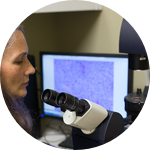About This Project
We all have harmless bacteria living in and on our bodies. For many reasons, they can become pathogenic and make us sick. Because of antimicrobial resistance and genetic mutation, people and pets still die of infection.
We've discovered an "extra-cellular" way to disrupt bacterial cells without antibiotic resistance. We believe it can help save lives.
Based on existing technology, we have our first antimicrobial in production, but it's hard for us to compete with Big Pharma's dominance.
Ask the Scientists
Join The DiscussionWhat is the context of this research?
Harmful bacteria live within us without causing disease until some event allows them to dominate beneficial bacteria. A cold or flu, poor diet, smoking, or an immune deficiency are all that it takes to turn bacteria in our bodies into promoters of disease.
It's possible to target harmful bacteria and kill them without harming their human host.
Chronic respiratory disease caused by bacteria is the most common disease in the US. Tooth decay and gum disease is a silent pandemic. Many people do not know they have it.
Look closely at your teeth and gums in the mirror. Your teeth should look shiny, your gums light pink. Do you see changes you hadn't noticed previously? Do your gums bleed when you brush? Signs of infection are subtle. There are no symptoms until decay and then sensitivity set in.
What is the significance of this project?
We have an ongoing clinical test of our product. It will tell us if our product works for real people and not just in a lab.
Lab tests are still important, however, as a way to better understand the mechanism of action of our product. Clinical and lab tests together provide us with a more global view of the problem and how we can solve it.
We've run a number of tests on bacterial communities. They indicate that our product changes bacteria. They are smaller and grow abnormally. They do not produce as much of a sticky substance called plaque that they use to adhere to their human host. We believe our product disrupts their cells in a way that does not affect their human host. We need to run this experiment on a single bacterial species to better understand these effects.
What are the goals of the project?
- We culture a bacterial species called S mutans in the lab.
- We determine a growth curve for S mutans.
- We then expose S mutans to our formulation. After exposure, we determine the S mutans growth curve again. All experiments are run with positive and negative controls.
- We study bacteria before and after exposure to our formulation with confocal microscopy (CM). With CM, we can measure changes in cell size, distance between cells, orientation of cells as they bud off (reproduce), and reduction of extra-cellular matrix (plaque) produced.
- We study the effect our product has on the S. mutans growth curve.
- We then compare our data to data taken previously. We see how bacteria in whole saliva and a single species compare in terms of growth.
- Finally, we look at both lab and clinical data together.
Budget
We're a small biotech company started for the sole purpose of curing disease. We have discovered how to use proven technology in a new way to fight infection. We're extremely close to demonstrating that we can cure illness. By summer, we'll have clinical data.
We've relied on support from interns and volunteers to get this far. We can't afford to pay salaries. We need to offer pay to attract highly skilled talent for this one test. Without funding, we can offer only a minimal and modest stipend. With this one additional test we'll be able to obtain more funding.
This year we've received volunteer support from several interns and under-employed scientists. We hope this work helps advance their careers.
Our product has a lot of uses. We're working hard to cure tooth decay and gum disease. So many people suffer from it. By summer, we'll publish clinical and lab results. If you're impressed and want to try our product yourself, you can.
If you decide to help us, thank you for your support!
Meet the Team
Team Bio
Dr. Mary Malast
I'm a scientist and engineer with 30 years of experience in the medical and aerospace fields. I'm the founder and owner of ArcSentry Technologies. We're a very small start up with no employees, but we have dedicated volunteers! We started as a non-profit, but switched to for-profit in order to attract investors and raise capital we must have for product development.
I earned a Master of Physics degree from California State University at Los Angeles and a Doctor of Science degree in Materials Science from Washington University at Saint Louis.
My years of experience enabled me to see an opportunity to help people. My work as a TEM microscopist and project manager in the medical field gave me the skills to see how.
In my spare time when I'm not teaching full-time and keeping the business moving forward, I volunteer at the Wild Bird Rehabilitation Center in Overland Missouri with my teenage daughter. We enjoy being close to nature, rescuing songbirds from illness or injury, and returning them to the wild.
Perhaps the reason I'm so passionate about curing disease is that I've suffered from chronic refractory sinusitis my entire adult life. After so many years of antibiotics and surgery that did not cure my infections, I began to think of sinusitis as a disability and learned to live with it. It is my goal to cure this terrible disease as well.
Additional Information
Did you know that your oral health might affect the health of your entire body? See this article from the Mayo clinic for a list of diseases and conditions that recent research suggests may be linked to your oral health. You could have periodontal disease without even knowing that you do.
And did you know that the American Veterinary Dental Society recently estimated 80% of dogs and 70% of cats show signs of oral and dental disease by age 3. AVMA says that periodontal disease is the most common clinical condition in cats and dogs. Our antimicrobial is safe for mammals including dogs and cats, but it must be reformulated for them. We're working on a formulation for dogs and cats now.
Here's a brief introduction to our oral care antimicrobial 1) clinical and 2) laboratory research. I'll post more details in experiment.com Lab Notes as our work progresses over the next few weeks.
1) Clinical test.
Our clinical test includes DNA data as well as a conventional clinical exam. Our clinical DNA test partner is Oral DNA Labs, Inc. Ask your dental professional about the test. Take it, if you can. Periodontal disease is asymptomatic until it is well established and often advanced. We've tested patients who were unaware they had periodontal disease (PD) risk, but had a moderate risk pathogen profile. We now know that oral pathogens can raise your risk of oral systemic diseases that may include cancer, heart disease, diabetes, autoimmune disease, and preterm birth.
We have a patient who did not know that they had a moderate PD disease risk profile until we gave them an oral DNA test. After 7 weeks of our antimicrobial treatment, this patient's follow up test was normal. They did not notice any difference in their teeth or gums while using our antimicrobial treatment. PD is not the only disease that the human body can resist while still functioning normally for many years. Heart disease, slow growing cancers, diabetes, and high blood pressure can all be largely asymptomatic for years.
Shown below is a conventional treatment case study and a case study for our antimicrobial. This link to www.mcclatchiedds.com is for my case study source. The study subject had a moderate PD disease risk profile (previous test), but was able to reduce that risk after conventional treatment (current test). A great deal of intervention and treatment was required, however, and the risk of re-infection remains. Below is the test result showing pre-treatment moderate periodontal disease with severe bleeding, inflammation, bone loss, discoloration, and concerning pocket depths (previous test), and the DNA test results after surgical and antibiotic treatment (current test). Each colored column represents a periodontal pathogen. See this sample DNA report or this report, Microbiological goals of periodontal therapy; Periodontology 2000, Vol. 42, 2006, 180-218, for full details of the pathogens and criteria for how they were selected for inclusion in the report.
Conventional treatment DNA result
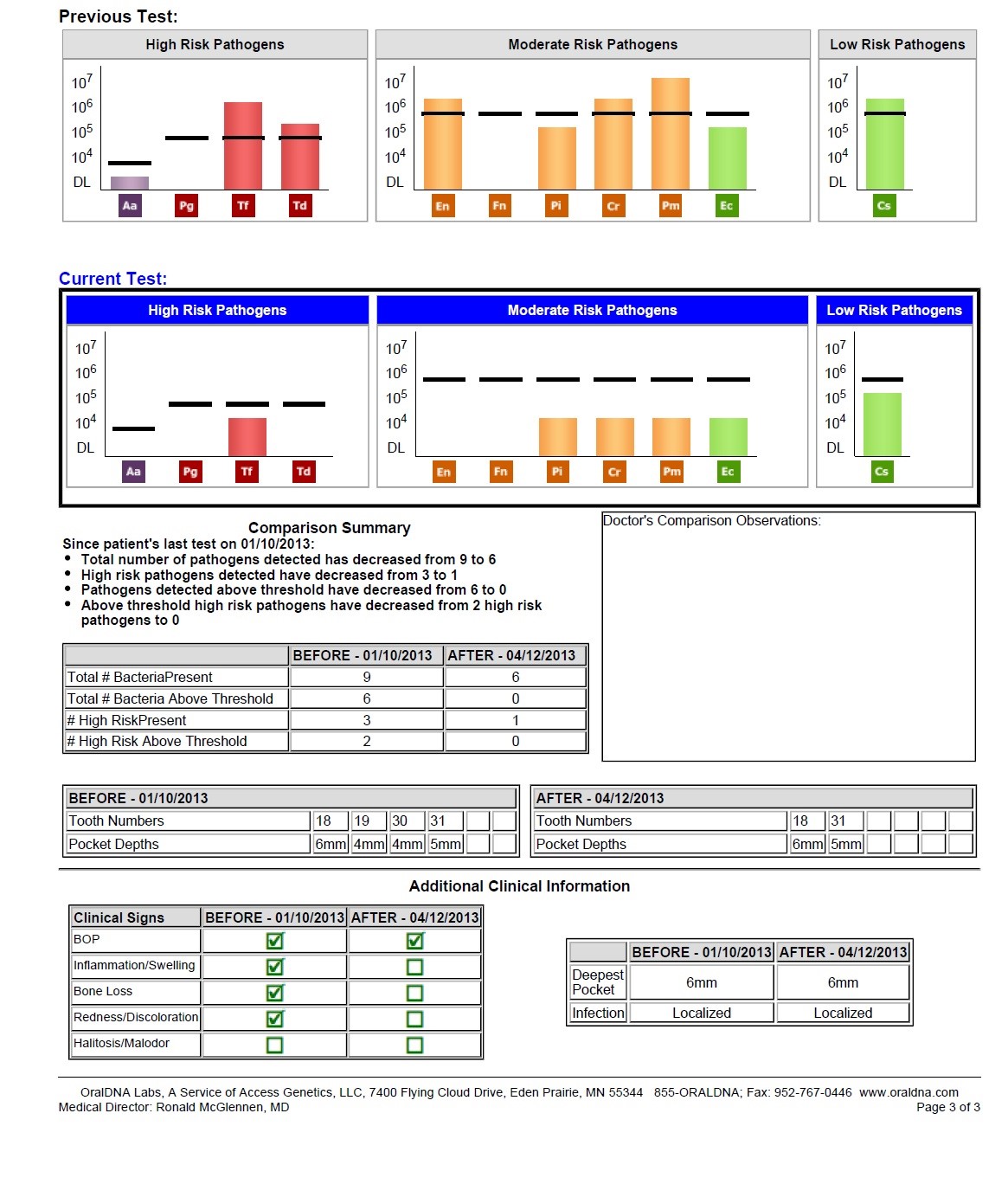
ArcSentry's antimicrobial results
Our antimicrobial achieved the following result in 7 weeks without surgery, systemic antibiotics, scaling and planing, or additional prophylaxis. Our product is safe for long-term use at a lower maintenance dose that can protect against re-infection with no risk of antibiotic resistance.
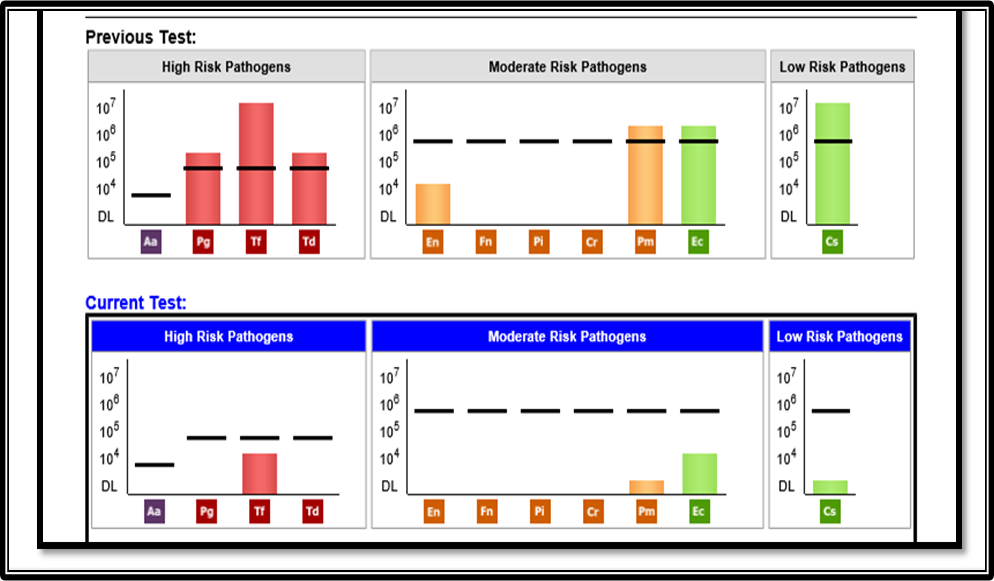
This is only one patient. Our clinical test will include over 100 patients so that we can use ANOVA to analyze our results. Still, we've been encouraged by our preliminary results. With as many as 1200 different oral microbes in human saliva, this data represents only a tiny glimpse at changes occurring during treatment. It will take years and many studies to understand the human oral microbial biome.
2) Laboratory tests.
Below are confocal and TEM images of whole saliva from a single donor before and after exposure to our antimicrobial. Most bacteria in saliva are rod shaped cocci like the ones seen below. Study these images for a few moments and you begin to see differences between the images where bacteria are exposed to the antimicrobial and images with no antimicrobial exposure. For example, there is less polysaccharide to bind bacteria to the bacterial colony in the "after exposure" images. The bacteria look puny and do not cluster as tightly together.
While clinical tests give us data at the macroscopic level, this is the other extreme in science, the extremely small scale. It gives us insight at the level of a single cell, but the small scale means small sample size. Microscopy data must always be combined with other large scale data before any conclusions can be drawn.
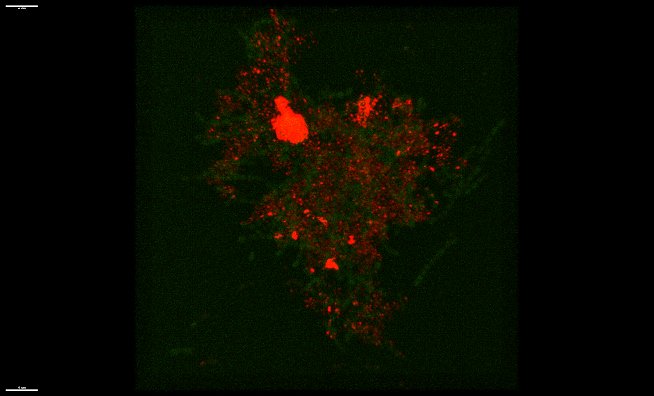
Confocal microscopy image of bacteria from whole saliva cultured in TY media at 37 deg C for 24 hours, with no in vivo or in vitro antimicrobial exposure. Calcophor (red, polysaccharides) and Syto (green, bacteria) dye. Scale at lower left is 3 microns.
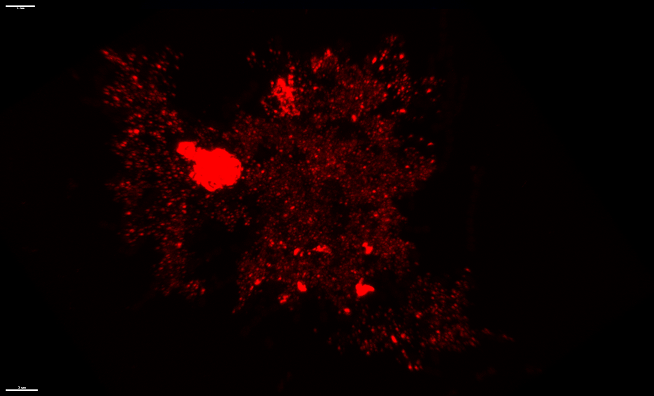
Confocal microscopy image of bacteria from whole saliva cultured in TY media at 37 deg C for 24 hours, with no in vivo or in vitro antimicrobial exposure. Calcophor (red, polysaccharides) only. Scale at lower left is 3 microns.
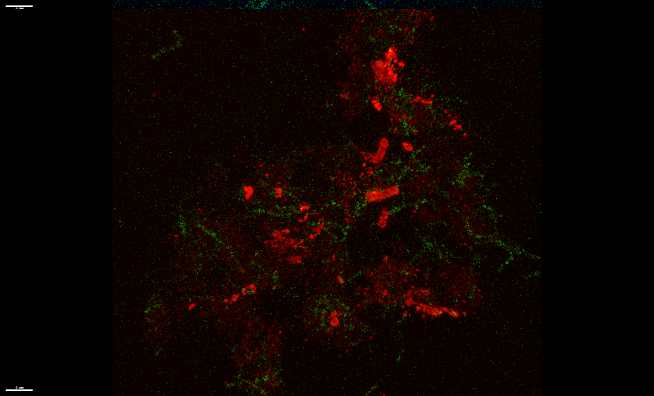
Confocal microscopy image of oral bacteria cultured in TY media at 37 deg C from whole saliva, in vitro exposure to antimicrobial only, no in vivo exposure (15 hours in vitro exposure time). Calcophor (red, polysaccharides) and Syto (green, bateria) dye. Scale at lower left is 3 microns.

Confocal microscopy image of oral bacteria cultured in TY media at 37 deg C from whole saliva, in vitro exposure to antimicrobial only, no in vivo exposure (15 hours in vitro exposure time). Calcophor (red, polysaccharides) only. Scale at lower left is 3 microns.
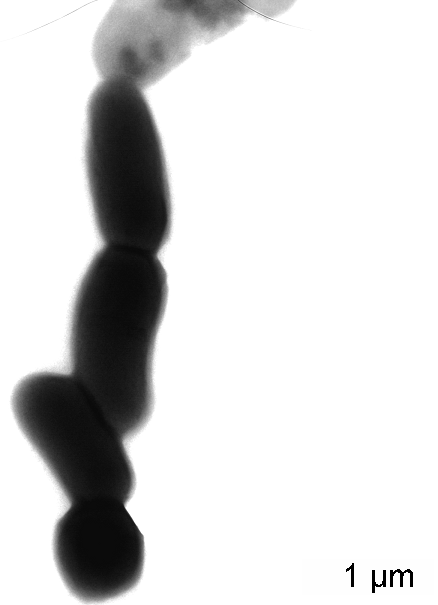
TEM image of cultured bacteria from whole saliva exposed to antimicrobial for 15 hours at 37 deg C in vitro, no in vivo exposure.
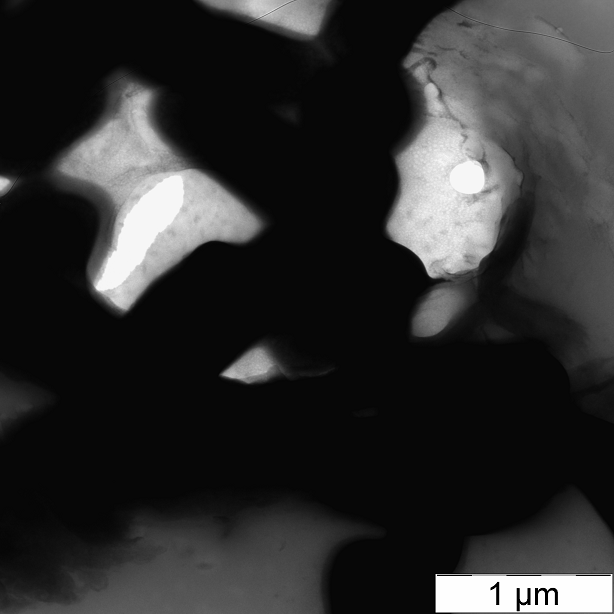

Cultured bacteria from whole saliva for 15 hours at 37 deg C, no exposure to antimicrobial in vitro, no in vivo exposure.
If you'd like to see us in the lab, please watch this short video.
Project Backers
- 0Backers
- 0%Funded
- $0Total Donations
- $0Average Donation
